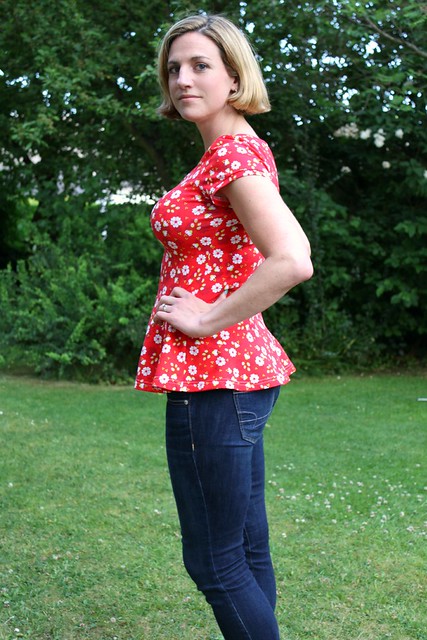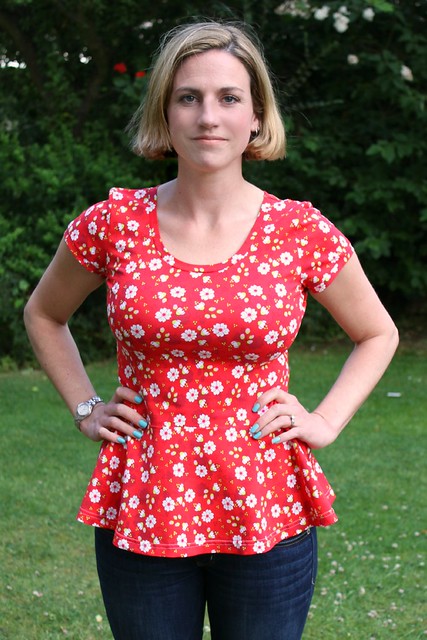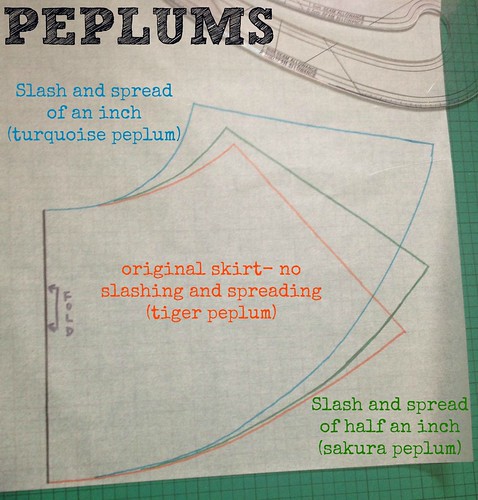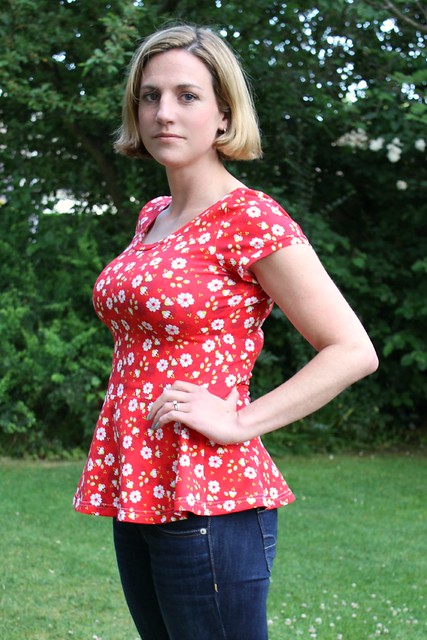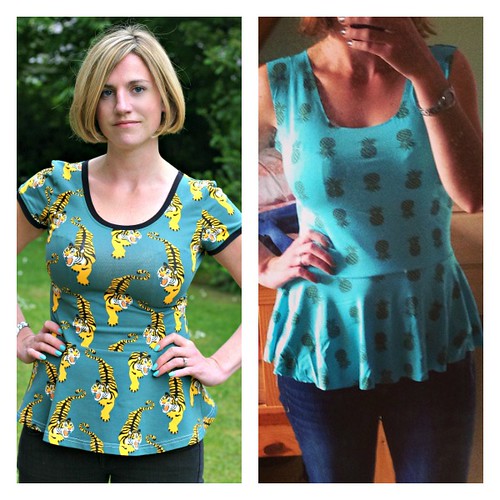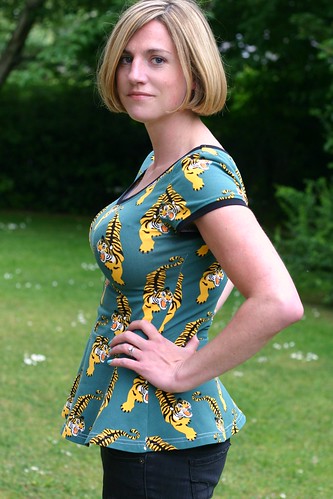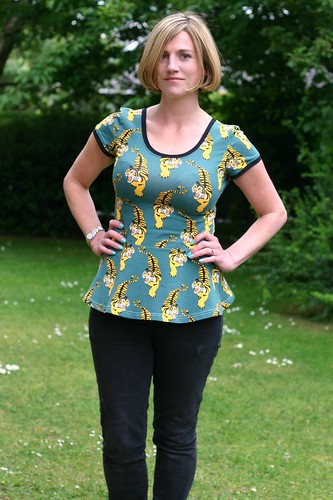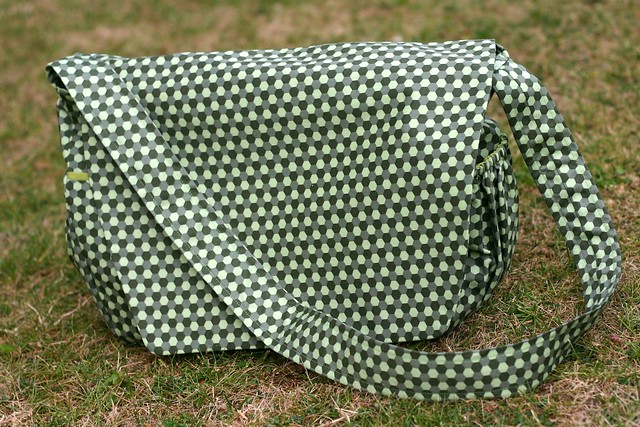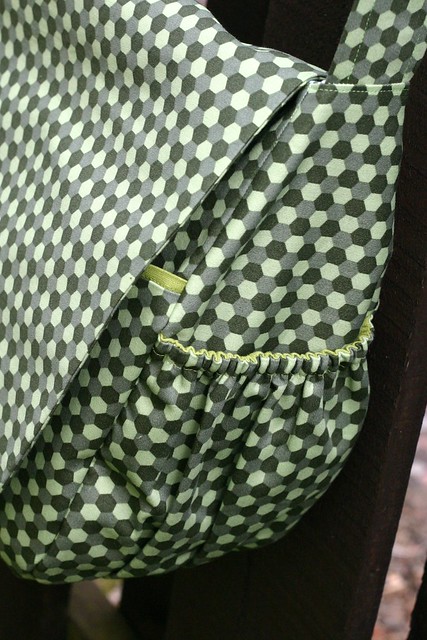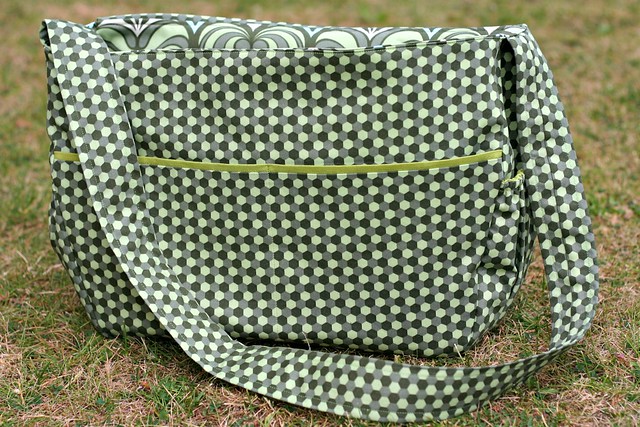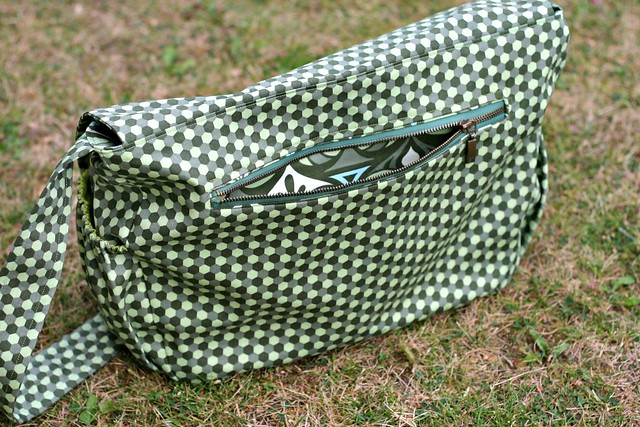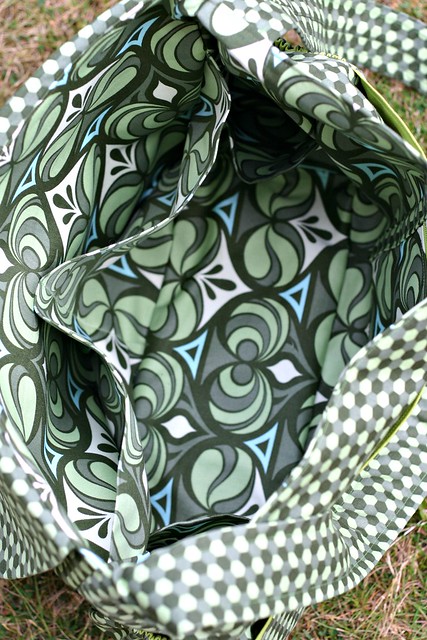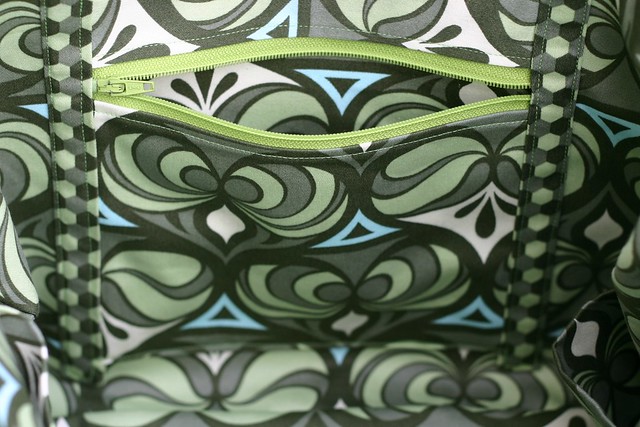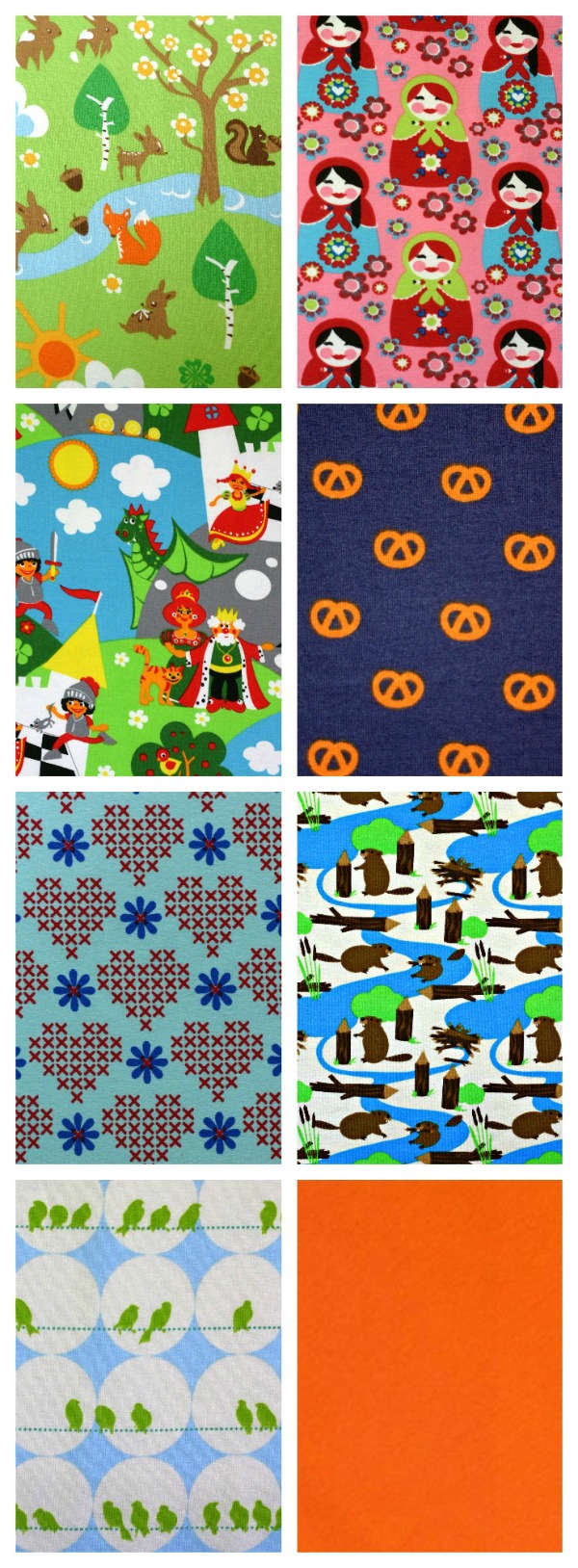Sunday, 30 June 2013
3
To complete my peplum experiment, I went the middle ground for peplum 3.0- fuller than the tiger peplum but less slash and spread than the turquoise peplum 1.0.
From the side it has a little more fullness than the tiger peplum, but the fabric is slightly thinner with a bit more drape so the overall silhouette is practically the same.
The front view definitely has a more obvious peplum appearance than the tiger top. Incidentally, I think I agree with Emily's comment on the last post that I could do with moving the waist seam down. More than an inch and I'd be venturing into a more 'problematic' tummy area but I think the overall silhouette would improve if the bodice was longer and the peplum section shorter.
So. If you're wanting to make your Lady Skater dress into a Lady Skater peplum, it's a choose your own adventure game! The orange pattern is the skirt piece unchanged (except for the length obviously)- no slashing and spreading at all. This is just over a half circle so there is still plenty of fullness and a nice curved waist seam that will offer some draping / skimming over the lower stomach. If you want to add even more fullness, it's the same process as I outlined in the Kids' Peplum Hack. Divide the skirt into four quarters (so three slash lines) and spread them apart:
For this Sakura middle-ground peplum, I spread the the sections apart by 1/2" each; for the original full peplum I spread them 1" each so it became almost a full circle. As you can see in the comparison Peplum picture above, the distance you are spreading not only affects the hem fullness but also the curve at the waist. The more drastic the curve, the more it will drape into those folds over the tummy.
If you are wanting to peplum your Lady Skater, how much fullness to use will be largely up to personal preference and the fabric you are using. If your fabric is thick and / or not very drapey, a fuller peplum will make a fairly pronounced cone shape. But if your fabric is thin and / or very drapey, a less full peplum might cling over the tummy and show off any lumps or bumps that would be skimmed over by a fuller peplum. There is no right or wrong peplum, just one that suits your own preferences and fabric choices.
In other news, these are the first pictures with my shiny new Canon 7D! Steven was stoked (this might be an overstatement, it is more accurate to say he was less irritated than normal) that he could shoot pictures in full auto instead of me messing around in manual to try to get everything right. And then normally making him go out a second or third time when I messed up my settings. Even better, he could take tonnes quickly in a row without a processing lag whereas my old Canon 1ti Rebel would only take a couple of shots before freezing. I'm so excited to get stuck in with the new camera.
Finally, as a blogger I think we're all supposed to make a statement this week about the demise of Google Reader. Tomorrow it'll be gone so make sure you import all your blog lists elsewhere. I made the transition to Feedly when I first heard and my initial thoughts are positive. I like that you can maintain your Reader folders by importing it directly and choosing which viewing style (title, magazine, cards and full) makes skimming and choosing which to expand easier than Reader. However, I've also heard rave reviews about Bloglovin and the ability to 'Like' posts (thereby improving their reach) is a very appealing feature for the way people read blogs these days. You can also follow by email subscription in the right sidebar.
Choose Your Own Adventure: Peplum Edition
To complete my peplum experiment, I went the middle ground for peplum 3.0- fuller than the tiger peplum but less slash and spread than the turquoise peplum 1.0.
From the side it has a little more fullness than the tiger peplum, but the fabric is slightly thinner with a bit more drape so the overall silhouette is practically the same.
The front view definitely has a more obvious peplum appearance than the tiger top. Incidentally, I think I agree with Emily's comment on the last post that I could do with moving the waist seam down. More than an inch and I'd be venturing into a more 'problematic' tummy area but I think the overall silhouette would improve if the bodice was longer and the peplum section shorter.
So. If you're wanting to make your Lady Skater dress into a Lady Skater peplum, it's a choose your own adventure game! The orange pattern is the skirt piece unchanged (except for the length obviously)- no slashing and spreading at all. This is just over a half circle so there is still plenty of fullness and a nice curved waist seam that will offer some draping / skimming over the lower stomach. If you want to add even more fullness, it's the same process as I outlined in the Kids' Peplum Hack. Divide the skirt into four quarters (so three slash lines) and spread them apart:
For this Sakura middle-ground peplum, I spread the the sections apart by 1/2" each; for the original full peplum I spread them 1" each so it became almost a full circle. As you can see in the comparison Peplum picture above, the distance you are spreading not only affects the hem fullness but also the curve at the waist. The more drastic the curve, the more it will drape into those folds over the tummy.
If you are wanting to peplum your Lady Skater, how much fullness to use will be largely up to personal preference and the fabric you are using. If your fabric is thick and / or not very drapey, a fuller peplum will make a fairly pronounced cone shape. But if your fabric is thin and / or very drapey, a less full peplum might cling over the tummy and show off any lumps or bumps that would be skimmed over by a fuller peplum. There is no right or wrong peplum, just one that suits your own preferences and fabric choices.
In other news, these are the first pictures with my shiny new Canon 7D! Steven was stoked (this might be an overstatement, it is more accurate to say he was less irritated than normal) that he could shoot pictures in full auto instead of me messing around in manual to try to get everything right. And then normally making him go out a second or third time when I messed up my settings. Even better, he could take tonnes quickly in a row without a processing lag whereas my old Canon 1ti Rebel would only take a couple of shots before freezing. I'm so excited to get stuck in with the new camera.
Finally, as a blogger I think we're all supposed to make a statement this week about the demise of Google Reader. Tomorrow it'll be gone so make sure you import all your blog lists elsewhere. I made the transition to Feedly when I first heard and my initial thoughts are positive. I like that you can maintain your Reader folders by importing it directly and choosing which viewing style (title, magazine, cards and full) makes skimming and choosing which to expand easier than Reader. However, I've also heard rave reviews about Bloglovin and the ability to 'Like' posts (thereby improving their reach) is a very appealing feature for the way people read blogs these days. You can also follow by email subscription in the right sidebar.
Friday, 28 June 2013
0
Stop the press: pink Blomma Birds, new Folklore Hearts, and MOAR VIKINGS
Guys, I apologise: I jumped the gun with the sale yesterday. There was one package of fabric that was outstanding but I didn't think it would arrive until I was closed up next week. Not so, the international postage gods must have been smiling on me and it arrived today! Sorry not sorry.
We have blue Vikings again! Like their authentic fore-bearers, we assumed that never again would those Vikings make a surprise appearance on British soil. But that's the thing about Vikings: they're never gone, they're just waiting for a surprise attack. I'm so happy to see them again.
We also have a new Folklore Hearts fabric in delicious petrol, red, pink, orange and green. And the popular Blomma Birds in tangerine, bubblegum pink, and red.
Discount codes still apply as follows:
I am presumptuous I am overwhelmed I wanted to give today and yesterday's customers the chance to see the new fabrics before shipping, I will hold off posting all sale orders until Monday.
All fabrics are still here!
We have blue Vikings again! Like their authentic fore-bearers, we assumed that never again would those Vikings make a surprise appearance on British soil. But that's the thing about Vikings: they're never gone, they're just waiting for a surprise attack. I'm so happy to see them again.
We also have a new Folklore Hearts fabric in delicious petrol, red, pink, orange and green. And the popular Blomma Birds in tangerine, bubblegum pink, and red.
Discount codes still apply as follows:
- Save 10% on fabric orders over £50 by using the code FABRICLOVER at checkout
- Save 15% on orders over £100 by using the code FABRICJUNKIE at checkout
All fabrics are still here!
Thursday, 27 June 2013
0
Shop News: SALE (yay!) and closing dates (boo)
Just to give plenty(ish) advanced warning but with the last day of school tomorrow and our upcoming America trip, I'll be closing the the shop up for everything except pdf patterns from early next week til sometime in late July. Is the thought of not having access to the most delicious jerseys for your summer sewing plans filling you with dread? Good news for you times two!
First up, discount codes:
Still need some extra enabling? When I receive a box of fabric, what I normally do is cut off a small piece for clothing making and list the remainder as per half metre cuts. This normally works out well but I occasionally end up with odd bits and pieces once the fabric has officially sold out. Sometimes I use them for present-making but mostly they just sit about taking up space. I desperately need more space. So I've raided my personal stash, and resurrected some of ye olde favourites in the LAST CHANCE section. Almost all of these are currently unavailable for reordering from the manufacturer (although sometimes they do cave to demand and reprint) so when they're gone, they're gone!
Head over to the shop if you're interested and remember to use your discount codes!
First up, discount codes:
- Save 10% on fabric orders over £50 by using the code FABRICLOVER at checkout
- Save 15% on orders over £100 by using the code FABRICJUNKIE at checkout
Still need some extra enabling? When I receive a box of fabric, what I normally do is cut off a small piece for clothing making and list the remainder as per half metre cuts. This normally works out well but I occasionally end up with odd bits and pieces once the fabric has officially sold out. Sometimes I use them for present-making but mostly they just sit about taking up space. I desperately need more space. So I've raided my personal stash, and resurrected some of ye olde favourites in the LAST CHANCE section. Almost all of these are currently unavailable for reordering from the manufacturer (although sometimes they do cave to demand and reprint) so when they're gone, they're gone!
Head over to the shop if you're interested and remember to use your discount codes!
Wednesday, 26 June 2013
13
I've been playing around with the skirt portion of the Lady Skater to peplum it. The first muslin (at the right) I used the same technique as the little Skater peplum tutorial, I slashed and spread the skirt so that it was a full circle. Despite not ironing or hemming (or cleaning the mirror or hiding bedroom detritus while we're discussing things I didn't do) I felt a bit hippy in a full circle peplum. This fabric is a very drapey fabric of undetermined content, and most of my jerseys are heavier cotton lycra blends with more body so IG recommendations to remove some of the fullness made a lot of sense; a short-length full circle peplum in the cotton lycra would've been almost conical! So for tiger peplum 2.0 I slashed and spread not at all. This is the straight skirt pattern piece just shortened to 9" (unhemmed). It has some drape and obviously ease through the hips compared to the negative ease of the bodice. Isn't it remarkable how differently the bodice fits in the two different fabrics?!
I like the silhouette from the side quite a bit, it's way more flattering on me than a traditional fitted t-shirt.
But from the front I'm not sure it's peplum-y enough or it just looks like a t-shirt with a strange bisecting seam and flare. Goldilocks segue... V1.0 peplum's too full? V2.0 peplum's too straight? Would a as-yet-undrafted middle ground V3.0 peplum be just right?
The Goldilocks Peplum
I've been playing around with the skirt portion of the Lady Skater to peplum it. The first muslin (at the right) I used the same technique as the little Skater peplum tutorial, I slashed and spread the skirt so that it was a full circle. Despite not ironing or hemming (or cleaning the mirror or hiding bedroom detritus while we're discussing things I didn't do) I felt a bit hippy in a full circle peplum. This fabric is a very drapey fabric of undetermined content, and most of my jerseys are heavier cotton lycra blends with more body so IG recommendations to remove some of the fullness made a lot of sense; a short-length full circle peplum in the cotton lycra would've been almost conical! So for tiger peplum 2.0 I slashed and spread not at all. This is the straight skirt pattern piece just shortened to 9" (unhemmed). It has some drape and obviously ease through the hips compared to the negative ease of the bodice. Isn't it remarkable how differently the bodice fits in the two different fabrics?!
I like the silhouette from the side quite a bit, it's way more flattering on me than a traditional fitted t-shirt.
But from the front I'm not sure it's peplum-y enough or it just looks like a t-shirt with a strange bisecting seam and flare. Goldilocks segue... V1.0 peplum's too full? V2.0 peplum's too straight? Would a as-yet-undrafted middle ground V3.0 peplum be just right?
Monday, 24 June 2013
3
My sister-in-law's sister is (over)due her first baby and I was commissioned to make her a changing bag. I used the same pattern that I drafted for my original Capacious Be-Pocketed Changing Bag, but I made it even more capacious and be-pocketed. Many apologies to Clare, the recipient of bag 1.0. Your bag is still great.
To the side we have two lined pockets that are gathered at the bottom and elasticated at the top, good for holding bottles or wallets snug and accessible. The side panels of version 2.0 are trapezoidal in nature rather than the rectangles of version 1.0- I tapered it to the width of the strap so it would hang better. The strap is cross-body length, made of self-fabric but with a webbing strap inside for stability. Speaking of stability, almost every piece is interfaced and some of the more important pieces are interlined with sturdy canvas as well. I'm lucky that my machine is such a workhorse with all those layers.
Underneath the messenger flap are two front pockets that are lined with green linen. I made the linen piece slightly taller so that it acts like a faux trim.
And to the back a large zippered welt pocket. The zipper was thrifted from one of Steven's old sweatshirts as, for reasons I can't explain, I've never bought a metal zip. I must rectify this travesty immediately.
Inside, there are two more full width pockets to the front lining, and two more full width side pockets (this time without elastication). Good for keeping nappy, wipes, phone, keys, etc separate and easily findable.
And just for extra snazzy there's an internal zippered patch pocket that I edged with the external fabric. No particular reason for doing it this way except it looks fancy.
Capacious Be-Pocketed Changing Bag: Keep It in the Family Edition
My sister-in-law's sister is (over)due her first baby and I was commissioned to make her a changing bag. I used the same pattern that I drafted for my original Capacious Be-Pocketed Changing Bag, but I made it even more capacious and be-pocketed. Many apologies to Clare, the recipient of bag 1.0. Your bag is still great.
To the side we have two lined pockets that are gathered at the bottom and elasticated at the top, good for holding bottles or wallets snug and accessible. The side panels of version 2.0 are trapezoidal in nature rather than the rectangles of version 1.0- I tapered it to the width of the strap so it would hang better. The strap is cross-body length, made of self-fabric but with a webbing strap inside for stability. Speaking of stability, almost every piece is interfaced and some of the more important pieces are interlined with sturdy canvas as well. I'm lucky that my machine is such a workhorse with all those layers.
Underneath the messenger flap are two front pockets that are lined with green linen. I made the linen piece slightly taller so that it acts like a faux trim.
And to the back a large zippered welt pocket. The zipper was thrifted from one of Steven's old sweatshirts as, for reasons I can't explain, I've never bought a metal zip. I must rectify this travesty immediately.
Inside, there are two more full width pockets to the front lining, and two more full width side pockets (this time without elastication). Good for keeping nappy, wipes, phone, keys, etc separate and easily findable.
And just for extra snazzy there's an internal zippered patch pocket that I edged with the external fabric. No particular reason for doing it this way except it looks fancy.
Wednesday, 19 June 2013
2
This just in: HEAPS
The biggest box ever arrived this week filled with loads of new fabrics:
From top to bottom we have Springtime, Matryoshkas, World of Knights, Pretzels, X Daisylove, Busy Beavers, Blomma birds, and bright orange plain jersey. All organics, all smooths as butter, all awesome. I have also restocked Sakura and Dancing in the Rain (Drops), and Icy Blue and Green Tigers. For the fabric-covetous, all can be found here!
From top to bottom we have Springtime, Matryoshkas, World of Knights, Pretzels, X Daisylove, Busy Beavers, Blomma birds, and bright orange plain jersey. All organics, all smooths as butter, all awesome. I have also restocked Sakura and Dancing in the Rain (Drops), and Icy Blue and Green Tigers. For the fabric-covetous, all can be found here!
Sunday, 16 June 2013
21
The Lady Skater: Fitting and Adjustments
I've had quite a few emails asking for fitting help so I'm going to delve into some common fitting adjustments here on the blog. If you have a question that isn't covered, throw it into the comments so other people can benefit from the hive mind!
It's clearly your lucky day as I turned pictures of me in my bathing suit into drawings for illustrative purposes. This shows my underbust line, high waist line, low waist line, and an entirely accurate belly button. Although I am slimmer towards my underbust, the intended seam line of the pattern (The Zone) falls around the high waist (if it was at the underbust it would become empire line which might indeed be cute but is not how I designed it). Like a lot of people that may or may not have had children, things become 'less streamlined' below my high waist so the seam falling above and the drape of the skirt should skim over that and be more flattering.
How do you find your Zone?
When drafting for grown-ups, there's no way to make a golden pattern that will fit everyone without adjustments. Not only are people different heights and sizes, but the distribution of their body parts varies wildly. The good news is that the Skater Dress only has one really important horizontal seam- the bodice / skirt seam. I am very short-waisted (that's actual me to the left), but I manipulated the pictures to show different torso builds for a proportional waist and a long waist. This is nothing to do with your overall height, but proportions. Although the busts are identical and the underbust lines even, the high waists and low waists shift incrementally. The standard pattern pieces for the Lady Skater are for the proportional waist in the middle, which means that even I have to make changes to my own pattern to fit me better!
If you have experience of making adult clothes for yourself, you probably have a good idea of your body type but if you're new to this a really useful exercise is to do just as I have: take a photo of yourself in your bathing suit or tight fitting clothes and trace around it. Find your underbust, high waist, low waist, and hip lines and look at how they are distributed. If you're still having having trouble conceptionalising, here are some (fast and loose) indications that you might have to tinker with your bodice length:
Lengthening your bodice
This is probably the most straight-forward change to make! All you need to do is split the pattern all the way across the lengthen line, add height with a piece of paper underneath, and smooth your side seams. The grey section is what you've added. Make sure you do the same change to your front and back bodice.
Shortening your bodice
Split your bodice along the shorten line, pull the bottom section up so that it overlaps with the top section (keeping the fold line aligned), and then smooth out your side seam. The grey section shows the overlap. Make sure you do the same change to your front and back bodice.
I'm happy with my front bodice length but my back bodice is hanging lower / I'm having pooling centre back:
As per my tutorial instructions, I highly recommend that you muslin the bodice before cutting precious hoarded fabric. When you make the bodice to ascertain if the waistline is hitting 'The Zone', you might notice when turning sideways that the back bodice is hanging lower than the front. Or- you might not notice until your final dress is finished and you want to know how to fix it. Uneven hems can be very common, particularly if you're busty. Now, I did a sway back adjustment to every size of the master pattern to try to counteract this but your own proportions might mean that you need to make further adjustments. Like the lengthen and shorten instructions above, what you need to do is slash your pattern along the lengthen / shorten line but do not cut through your size line on the side seam, only cut very close to it. Swing the lower section upwards so that you are overlapping the upper section at the centre back. This probably won't need to be a huge overlap (3/4" to 1"), and tape in place. The centre edge of the lower section will swing over the vertical fold line. Return this line to vertical and (if required) add the same amount of width that you removed at the centre vertical to the side seam. The sway back adjustment is essentially taking a wedge out of centre back to reduce pooling, nothing else is changing in a major way. Depending on how much you removed, you might need to smooth your bottom seam line so it's convex rather than a harsh angle. If you only found this pooling after your entire dress was complete, try it on inside out and with the help of a friend pull the back bodice / skirt seam up until the hem is even and pin in place. Seam-rip along the centre back (the side seams should be unaffected), remove the excess to the back bodice piece and re-sew. If you find pooling both at the front and the back your bodice is too long.
My high bust and waist aren't the same sizes:
When you are measuring your high bust and high waist, you might find that your high bust corresponds to a different size than your waist. The above picture shows smoothing the side seam between smaller bust / larger waist and larger bust / smaller waist. When blending sizes, the majority of the extra room happens in the bust where its needed.
Depending on your fabric choice and your cup size, you might find that you need more room in the bust only. Using a fabric with less stretch capacity like interlock or jersey without lycra might result in a drag line across the full bust. Fixing this is almost the same as blending a larger bust to smaller waist except you're doing it to the front bodice only. Adding extra width to the armhole and upper bodice means that you'll have to also add the same amount to the front sleeve so it fits. If the front bodice side seam becomes slightly longer than the back bodice side seam, ease the extra length into the top half of the seam where the bust is.
**EDITED TO ADD ANOTHER ONE BASED ON COMMENTS**
Shortening the shoulder height / Upper bust height:
If you find that after making a bodice muslin that there is pooling above your bust towards the sleeve hole, or that the sleeve cap is sitting funky off your shoulder cap, you might need to shorten your shoulder height or shoulder width. With your bodice muslin on inside out, pinch the shoulder seam to bring it up and pin out the excess. On your paper pattern, match the amount you pinned out to the corresponding smaller size (for example, if you pinned 1/4" below the shoulder seam you would go down one size to both the front and back bodices, 1/2" goes down two sizes, etc). Use that armscye / sleeve hole but when you get to the side seam increase the width to your original size. In the picture above (as per Lyn's adjustments in the comments!), I'm showing how to use the upper bust and shoulder of a size 3 with the width of the size 6 in the lower bodice. Use the sleeve of the smaller size but add the extra width at the front and back corners to reflect the size of your lower bodice.
I hope all of this helps! If you have a question about fitting that I haven't covered, chuck it in the comments.
It's clearly your lucky day as I turned pictures of me in my bathing suit into drawings for illustrative purposes. This shows my underbust line, high waist line, low waist line, and an entirely accurate belly button. Although I am slimmer towards my underbust, the intended seam line of the pattern (The Zone) falls around the high waist (if it was at the underbust it would become empire line which might indeed be cute but is not how I designed it). Like a lot of people that may or may not have had children, things become 'less streamlined' below my high waist so the seam falling above and the drape of the skirt should skim over that and be more flattering.
How do you find your Zone?
When drafting for grown-ups, there's no way to make a golden pattern that will fit everyone without adjustments. Not only are people different heights and sizes, but the distribution of their body parts varies wildly. The good news is that the Skater Dress only has one really important horizontal seam- the bodice / skirt seam. I am very short-waisted (that's actual me to the left), but I manipulated the pictures to show different torso builds for a proportional waist and a long waist. This is nothing to do with your overall height, but proportions. Although the busts are identical and the underbust lines even, the high waists and low waists shift incrementally. The standard pattern pieces for the Lady Skater are for the proportional waist in the middle, which means that even I have to make changes to my own pattern to fit me better!
If you have experience of making adult clothes for yourself, you probably have a good idea of your body type but if you're new to this a really useful exercise is to do just as I have: take a photo of yourself in your bathing suit or tight fitting clothes and trace around it. Find your underbust, high waist, low waist, and hip lines and look at how they are distributed. If you're still having having trouble conceptionalising, here are some (fast and loose) indications that you might have to tinker with your bodice length:
- Your overall height. The pattern is graded for a 5'5" woman. If you are shorter than 5'5" or taller than 5'5" you will probably need to utilise the lengthen / shorten line on the bodice.
- Your torso proportions. Again, this takes some body awareness and experience, but if you are short or long waisted you will need to adjust the bodice piece to remove or add height.
- Bust size. This is the least important factor of the three but if you are of the small to average bust you might need to shorten your bodice as less of the fabric is being used to go up and over the breasts. Equally, very large busts might need to add length to the front bodice piece / remove length from the back bodice to have an evenly hanging hemline.
Lengthening your bodice
This is probably the most straight-forward change to make! All you need to do is split the pattern all the way across the lengthen line, add height with a piece of paper underneath, and smooth your side seams. The grey section is what you've added. Make sure you do the same change to your front and back bodice.
Shortening your bodice
Split your bodice along the shorten line, pull the bottom section up so that it overlaps with the top section (keeping the fold line aligned), and then smooth out your side seam. The grey section shows the overlap. Make sure you do the same change to your front and back bodice.
I'm happy with my front bodice length but my back bodice is hanging lower / I'm having pooling centre back:
As per my tutorial instructions, I highly recommend that you muslin the bodice before cutting precious hoarded fabric. When you make the bodice to ascertain if the waistline is hitting 'The Zone', you might notice when turning sideways that the back bodice is hanging lower than the front. Or- you might not notice until your final dress is finished and you want to know how to fix it. Uneven hems can be very common, particularly if you're busty. Now, I did a sway back adjustment to every size of the master pattern to try to counteract this but your own proportions might mean that you need to make further adjustments. Like the lengthen and shorten instructions above, what you need to do is slash your pattern along the lengthen / shorten line but do not cut through your size line on the side seam, only cut very close to it. Swing the lower section upwards so that you are overlapping the upper section at the centre back. This probably won't need to be a huge overlap (3/4" to 1"), and tape in place. The centre edge of the lower section will swing over the vertical fold line. Return this line to vertical and (if required) add the same amount of width that you removed at the centre vertical to the side seam. The sway back adjustment is essentially taking a wedge out of centre back to reduce pooling, nothing else is changing in a major way. Depending on how much you removed, you might need to smooth your bottom seam line so it's convex rather than a harsh angle. If you only found this pooling after your entire dress was complete, try it on inside out and with the help of a friend pull the back bodice / skirt seam up until the hem is even and pin in place. Seam-rip along the centre back (the side seams should be unaffected), remove the excess to the back bodice piece and re-sew. If you find pooling both at the front and the back your bodice is too long.
My high bust and waist aren't the same sizes:
When you are measuring your high bust and high waist, you might find that your high bust corresponds to a different size than your waist. The above picture shows smoothing the side seam between smaller bust / larger waist and larger bust / smaller waist. When blending sizes, the majority of the extra room happens in the bust where its needed.
Depending on your fabric choice and your cup size, you might find that you need more room in the bust only. Using a fabric with less stretch capacity like interlock or jersey without lycra might result in a drag line across the full bust. Fixing this is almost the same as blending a larger bust to smaller waist except you're doing it to the front bodice only. Adding extra width to the armhole and upper bodice means that you'll have to also add the same amount to the front sleeve so it fits. If the front bodice side seam becomes slightly longer than the back bodice side seam, ease the extra length into the top half of the seam where the bust is.
**EDITED TO ADD ANOTHER ONE BASED ON COMMENTS**
Shortening the shoulder height / Upper bust height:
If you find that after making a bodice muslin that there is pooling above your bust towards the sleeve hole, or that the sleeve cap is sitting funky off your shoulder cap, you might need to shorten your shoulder height or shoulder width. With your bodice muslin on inside out, pinch the shoulder seam to bring it up and pin out the excess. On your paper pattern, match the amount you pinned out to the corresponding smaller size (for example, if you pinned 1/4" below the shoulder seam you would go down one size to both the front and back bodices, 1/2" goes down two sizes, etc). Use that armscye / sleeve hole but when you get to the side seam increase the width to your original size. In the picture above (as per Lyn's adjustments in the comments!), I'm showing how to use the upper bust and shoulder of a size 3 with the width of the size 6 in the lower bodice. Use the sleeve of the smaller size but add the extra width at the front and back corners to reflect the size of your lower bodice.
I hope all of this helps! If you have a question about fitting that I haven't covered, chuck it in the comments.
Friday, 14 June 2013
17
The Lady Skater Dress: FAQs and further information
Firstly, thanks for all the support everyone has thrown
behind me and my first adult pattern! I'm so grateful for all you guys,
truly. I hasn't gone without hitches but it's gone and that's something.
Those of you that follow me on Instagram might have seen that I had to do a complete rebranding within a couple of hours of the launch! As hard as it is to believe, there are loads of people who don't read my blog and were unaware that I had a girls' skater dress. So our in-joke of Big Girl / Little Girl lost its context and Big Girl became Plus Size. Now, I have zero problems with being aligned with 'Plus Size' and probably the largest sizes I offer are indeed 'Plus Size' by some definitions but there are also very small sizes so I needed to rename to reflect that. Not that everyone has been happy with Lady Skater as a name but hey-ho :) I guess if there's a lesson to be learned it's that everyone should read my blog.
Why did I name my sizes 1 through 8?
Several reasons! Firstly, the sizes included in all patterns are relative. Having eight sizes means that they could've potentially been called XXS, XS, S, M, L, XL, XXL, and XXXL but that's misleading because it's relative to my own grade rule and how many sizes I included. Like it or not, relative sizes like XS or XXL carry meaning as to where you fall in comparison 'average' and I feel very strongly about not doing that. So why didn't I use sizes in relation to off-the-rack clothes (like 2, 6, 8, 10, 12 etc)? My cop-out answer is that my customers come from all over the world so researching how I should marry UK / US / EU sizes accurately would've been tricky (even more so as off-the-rack sizes vary wildly between manufacturers and even within the same manufacturer due to different factories of origin). But more than that, numbers again carry weight. I want people to choose their size based on their own measurements, not because of conditioned responses like 'I'm an 6'.
Why do you use your high bust measurement and not your full bust?
Full bust measurements vary wildly, high bust measurements less so. For smaller or average busted people, choosing a sized based on your full bust might be the same size as it would be on your high bust (more likely it would be 1-2 sizes up). But if there's a large difference between your full and high bust and you choose size based on full bust, it will be way too big through the shoulders and upper bust. Katie is doing a really interesting experiment of sewing big-4 patterns based on full and high busts if you want to read more about it (clue: you do). This is a knit dress so a lot of our full bust differences will be taken care of through negative ease but if you find that you need extra room for the girls, you can add it where it's needed: the bust. This might be as simple as increasing the width of the front bodice under the arm, or you might need to do a more official FBA to increase the length of the front bodice too. I'll be talking more about this in a fitting post.
What is clear elastic and why should I use it?
The Lady Skater calls for you to insert clear elastic into your shoulder seams and your bodice / skirt seams. If you've never come across it before, clear elastic is an elastic that you can insert inside your seams to stabilise them and stop them from distorting over time. It's not 100% essentialit totally is but it's easy to sew in and will greatly improve the longevity of your dress. How clear elastic differs from other elastics is its stability. If you cut a 5" piece of (good quality) clear elastic and stretch it out, when you let go it'll go back to 5"*. When inserted into a seam, clear elastic means that the seam can stretch, but that it won't overstretch, particularly over time. An interlock dress without clear elastic will start losing its intended dimenstions through wear for example. In a fabric with a highish lycra content, clear elastic is less important but I'm still going to attempt to convince you.
Inserting the elastic in the seams couldn't be easier! Rather than trying to sew it in while you're sewing your shoulder or bodice / skirt seams (which is admittedly trickier to catch all three layers), the elastic is basted on to the wrong side of the fabric before attaching pieces to one another. I use a 2.5 x 2 zigzag and the stability of the elastic is great enough that it's no harder than basting on a woven ribbon- you're not stretching it at all so it really does behave like that.
Tl;dr: Clear elastic is the business.
*For this reason you can also use clear elastic for gathering! Cut the length you require for the final intended size and sew it on while stretching it to fit the fabric. For example, you want to make a 15" piece of fabric gathered to 10". Cut a 10" length of elastic, tack it to the fabric at either edge and then sew it on while stretching the elastic and it will gather to 10" (or slightly more if your fabric is dense).
Those of you that follow me on Instagram might have seen that I had to do a complete rebranding within a couple of hours of the launch! As hard as it is to believe, there are loads of people who don't read my blog and were unaware that I had a girls' skater dress. So our in-joke of Big Girl / Little Girl lost its context and Big Girl became Plus Size. Now, I have zero problems with being aligned with 'Plus Size' and probably the largest sizes I offer are indeed 'Plus Size' by some definitions but there are also very small sizes so I needed to rename to reflect that. Not that everyone has been happy with Lady Skater as a name but hey-ho :) I guess if there's a lesson to be learned it's that everyone should read my blog.
Why did I name my sizes 1 through 8?
Several reasons! Firstly, the sizes included in all patterns are relative. Having eight sizes means that they could've potentially been called XXS, XS, S, M, L, XL, XXL, and XXXL but that's misleading because it's relative to my own grade rule and how many sizes I included. Like it or not, relative sizes like XS or XXL carry meaning as to where you fall in comparison 'average' and I feel very strongly about not doing that. So why didn't I use sizes in relation to off-the-rack clothes (like 2, 6, 8, 10, 12 etc)? My cop-out answer is that my customers come from all over the world so researching how I should marry UK / US / EU sizes accurately would've been tricky (even more so as off-the-rack sizes vary wildly between manufacturers and even within the same manufacturer due to different factories of origin). But more than that, numbers again carry weight. I want people to choose their size based on their own measurements, not because of conditioned responses like 'I'm an 6'.
Why do you use your high bust measurement and not your full bust?
Full bust measurements vary wildly, high bust measurements less so. For smaller or average busted people, choosing a sized based on your full bust might be the same size as it would be on your high bust (more likely it would be 1-2 sizes up). But if there's a large difference between your full and high bust and you choose size based on full bust, it will be way too big through the shoulders and upper bust. Katie is doing a really interesting experiment of sewing big-4 patterns based on full and high busts if you want to read more about it (clue: you do). This is a knit dress so a lot of our full bust differences will be taken care of through negative ease but if you find that you need extra room for the girls, you can add it where it's needed: the bust. This might be as simple as increasing the width of the front bodice under the arm, or you might need to do a more official FBA to increase the length of the front bodice too. I'll be talking more about this in a fitting post.
What is clear elastic and why should I use it?
The Lady Skater calls for you to insert clear elastic into your shoulder seams and your bodice / skirt seams. If you've never come across it before, clear elastic is an elastic that you can insert inside your seams to stabilise them and stop them from distorting over time. It's not 100% essential
Inserting the elastic in the seams couldn't be easier! Rather than trying to sew it in while you're sewing your shoulder or bodice / skirt seams (which is admittedly trickier to catch all three layers), the elastic is basted on to the wrong side of the fabric before attaching pieces to one another. I use a 2.5 x 2 zigzag and the stability of the elastic is great enough that it's no harder than basting on a woven ribbon- you're not stretching it at all so it really does behave like that.
Tl;dr: Clear elastic is the business.
*For this reason you can also use clear elastic for gathering! Cut the length you require for the final intended size and sew it on while stretching it to fit the fabric. For example, you want to make a 15" piece of fabric gathered to 10". Cut a 10" length of elastic, tack it to the fabric at either edge and then sew it on while stretching the elastic and it will gather to 10" (or slightly more if your fabric is dense).
Wednesday, 12 June 2013
15
Bang the drums and release the hounds, the Lady Skater is now available for people who aren't me. I'd like to thank my parents, my coffee machine, pesterers, and Photoshop. And of course my awesome testers! Here are just some of the pics that are already in the public domain:
Although I spent countless hours messing with my own pictures to turn them into pattern's line drawings, I also had the added pleasure of messing with other people's pictures just for sh*ts and giggles. Agreeing to let me use your images is both a blessing and a curse:
If you want to read what testers have to say about the pattern, Katie, Cindy and Alida have all blogged about it already! As others pop up I'll add them to this post.
And if you want to check out all the details about the pattern, you can find it here!
The Lady Skater Dress Sewing Pattern is go!
Bang the drums and release the hounds, the Lady Skater is now available for people who aren't me. I'd like to thank my parents, my coffee machine, pesterers, and Photoshop. And of course my awesome testers! Here are just some of the pics that are already in the public domain:
Although I spent countless hours messing with my own pictures to turn them into pattern's line drawings, I also had the added pleasure of messing with other people's pictures just for sh*ts and giggles. Agreeing to let me use your images is both a blessing and a curse:
If you want to read what testers have to say about the pattern, Katie, Cindy and Alida have all blogged about it already! As others pop up I'll add them to this post.
And if you want to check out all the details about the pattern, you can find it here!
Friday, 7 June 2013
1
Crafterhours' Skirt Week- Deadline Ahoy
Just a reminder that the pools are a-closing for the Crafterhour's Skirt Week Competition today. We lucky Europe-livers get the wee small hours to feverishly sew and submit as the Flickr pools close at midnight East Coast time. If you're lacking inspiration at this late hour, their blog has had loads of tutes this week or you could always check out their Pinterest Skirt Tutorial Board (which includes all of this weeks' tutes plus many, many more of which my pettiskirt and tennis skirt tutes are obviously the best ). There are women's categories for a-line, a full skirt, a straight skirt, and of course- the kids' category:
'But why aren't you partaking this year, Amanda?' I hear you ask. Because I'm a judge! I'm helping out in the kids' category and it's so hard to choose my favourites. The above picture is shows all the talent on just one of the pages. Yikes. So if you want to partake (and you totally still have time), check out the rules first and then add to the relevant pool.
'But why aren't you partaking this year, Amanda?' I hear you ask. Because I'm a judge! I'm helping out in the kids' category and it's so hard to choose my favourites. The above picture is shows all the talent on just one of the pages. Yikes. So if you want to partake (and you totally still have time), check out the rules first and then add to the relevant pool.
Thursday, 6 June 2013
25
And now for something completely out of character for me: not only talking about my face but inviting you to look at it quite closely. I posted this picture on Instagram a couple of weeks ago and quite a few people wanted me to elaborate on what I was talking about. In short, the Oil Cleansing Method. I've been doing it for just over a month now and feel like a long enough period of time has elapsed for me to pass opinion.
If you're unfamiliar with the Oil Cleansing Method, the basic principle is that using traditional chemical-based products to cleanse, tone, and moisturise strips away the natural oils in your skin, which in turn responds by either over-producing oil or generally becoming dry and / or irritated. With OCM, you eschew chemical products and instead use oil to cleanse, tone and moisturise on the basis that oil cleans oil. I researched it for a very long time, watched friends try it (with and without success I must add), but the idea of massaging oil into my skin was so terrifying to my with-oil-comes-acne mindset that I was too nervous to try. And then a couple of things convinced me it was worth a shot. This neverending winter, our freezing house, and my natural tendency to be cold all the time meant that central heating, calor gas heating, and my electric heater got more than normal-usage this year. I was gifted a facial for my birthday last year and the beauty therapist was (a polite version of) oh dear god your skin is so dry you must exfoliate. I did exfoliate but then my face was painfully dry and pinched, the default condition of my skin since forever, which I would attempt to treat by slathering on moisturiser for temporary relief, and repeat. I also have problem skin, exfoliating and moisturing generally irritate it and if I don't have a couple of spots on the go at any given time (including a stubborn cystic one) is a rare and glorious experience. Add this to my (not proud of it but hey) increasing vanity about lines as I'm marching into my mid-thirties, and I finally decided I had nothing to lose if I gave OCM a try. My skin couldn't get any drier, and I had enough spots that what was a few more?
Rather than invest in pricier oils from the off, I started with just extra virgin olive oil. You massage about a five pence piece (dime size for Americans) into your skin in circular motions and then hold a piping hot washcloth against your face once or twice, and then use the same circular motions with your washcloth to exfoliate and rub the excess oil off. I did this before bed, and after a week off nothing terrible happening, and actual soft skin that didn't hurt to move, I invested in some extra oils. All of the research I read suggested that it can take a bit of experimenting to get the balance of your oil mixture right so I bought quite a few: jojoba, sweet almond, apricot kernel, grapeseed, and castor. The former are all 'carrier' oils, and the castor is a beast of a different nature: it's an oil that draws out all of the yuck in your pores but is too drying to use without combining with a larger proportion of carrier oil. From what I've read, the typical proportion of carrier to castor is 66% /33% (or 75% / 25%) although everyone is different and it can take some experimenting with which oils to use and in which proportions. At the moment I'm using 25% olive oil, 50% jojoba, and 25 % castor (a third castor was too drying so I added a bit more carrier to my mixture). Although my skin gets a bit drier than than the straight-up EVOO I started with, I'm happy to continue with this mix because the castor is a natural cleanser. If I feel I need it I'll rub a couple of drops of straight almond oil in just before bed, or a couple of drop of apricot kernel or grapeseed oils in (both lighter than Almond) during the day.
And now for my completely un-scientific picture comparison; obviously the left is taken in bright light and the right in more flattering light so it's not really like-for-like-holy-sh*t-will-you-look-at-that. But to the person who is most au fait with my face (ie me, sorry mum you were a close second!), the fine lines around my eyes which I attribute to lack of moisture and definitely not getting old look improved. And even if they don't look any different at all, my face feels so much better. Softer, smoother, more evenly toned, a bit glowier, and not at all tight or sore. I've gotten precisely one cystic spot in a month (gigantic improvement) and it went away in a couple of days with neat castor oil. Not lying. Overall, OCM is been the absolute best for me and the £20 I spent on oil should last more than six months.
Next up on the hippy train is no-poo (not at all what it sounds like, it's about aschewing shampoo). Anyone have any advice or anecdata? Have you tried Oil Cleansing and how did it work for you?
Addendum: I'm not an expert nor do I play one on TV. Almost everything I learned about the Oil Cleansing Method is from Crunchy Betty, which is the awesomest site, and then trial and error. Her introduction to oil cleansing is essential reading if you're new to the idea, and there are even forums if you need advice.
The Oil Cleansing Method: One Month In
And now for something completely out of character for me: not only talking about my face but inviting you to look at it quite closely. I posted this picture on Instagram a couple of weeks ago and quite a few people wanted me to elaborate on what I was talking about. In short, the Oil Cleansing Method. I've been doing it for just over a month now and feel like a long enough period of time has elapsed for me to pass opinion.
If you're unfamiliar with the Oil Cleansing Method, the basic principle is that using traditional chemical-based products to cleanse, tone, and moisturise strips away the natural oils in your skin, which in turn responds by either over-producing oil or generally becoming dry and / or irritated. With OCM, you eschew chemical products and instead use oil to cleanse, tone and moisturise on the basis that oil cleans oil. I researched it for a very long time, watched friends try it (with and without success I must add), but the idea of massaging oil into my skin was so terrifying to my with-oil-comes-acne mindset that I was too nervous to try. And then a couple of things convinced me it was worth a shot. This neverending winter, our freezing house, and my natural tendency to be cold all the time meant that central heating, calor gas heating, and my electric heater got more than normal-usage this year. I was gifted a facial for my birthday last year and the beauty therapist was (a polite version of) oh dear god your skin is so dry you must exfoliate. I did exfoliate but then my face was painfully dry and pinched, the default condition of my skin since forever, which I would attempt to treat by slathering on moisturiser for temporary relief, and repeat. I also have problem skin, exfoliating and moisturing generally irritate it and if I don't have a couple of spots on the go at any given time (including a stubborn cystic one) is a rare and glorious experience. Add this to my (not proud of it but hey) increasing vanity about lines as I'm marching into my mid-thirties, and I finally decided I had nothing to lose if I gave OCM a try. My skin couldn't get any drier, and I had enough spots that what was a few more?
Rather than invest in pricier oils from the off, I started with just extra virgin olive oil. You massage about a five pence piece (dime size for Americans) into your skin in circular motions and then hold a piping hot washcloth against your face once or twice, and then use the same circular motions with your washcloth to exfoliate and rub the excess oil off. I did this before bed, and after a week off nothing terrible happening, and actual soft skin that didn't hurt to move, I invested in some extra oils. All of the research I read suggested that it can take a bit of experimenting to get the balance of your oil mixture right so I bought quite a few: jojoba, sweet almond, apricot kernel, grapeseed, and castor. The former are all 'carrier' oils, and the castor is a beast of a different nature: it's an oil that draws out all of the yuck in your pores but is too drying to use without combining with a larger proportion of carrier oil. From what I've read, the typical proportion of carrier to castor is 66% /33% (or 75% / 25%) although everyone is different and it can take some experimenting with which oils to use and in which proportions. At the moment I'm using 25% olive oil, 50% jojoba, and 25 % castor (a third castor was too drying so I added a bit more carrier to my mixture). Although my skin gets a bit drier than than the straight-up EVOO I started with, I'm happy to continue with this mix because the castor is a natural cleanser. If I feel I need it I'll rub a couple of drops of straight almond oil in just before bed, or a couple of drop of apricot kernel or grapeseed oils in (both lighter than Almond) during the day.
And now for my completely un-scientific picture comparison; obviously the left is taken in bright light and the right in more flattering light so it's not really like-for-like-holy-sh*t-will-you-look-at-that. But to the person who is most au fait with my face (ie me, sorry mum you were a close second!), the fine lines around my eyes which I attribute to lack of moisture and definitely not getting old look improved. And even if they don't look any different at all, my face feels so much better. Softer, smoother, more evenly toned, a bit glowier, and not at all tight or sore. I've gotten precisely one cystic spot in a month (gigantic improvement) and it went away in a couple of days with neat castor oil. Not lying. Overall, OCM is been the absolute best for me and the £20 I spent on oil should last more than six months.
Next up on the hippy train is no-poo (not at all what it sounds like, it's about aschewing shampoo). Anyone have any advice or anecdata? Have you tried Oil Cleansing and how did it work for you?
Addendum: I'm not an expert nor do I play one on TV. Almost everything I learned about the Oil Cleansing Method is from Crunchy Betty, which is the awesomest site, and then trial and error. Her introduction to oil cleansing is essential reading if you're new to the idea, and there are even forums if you need advice.
Tuesday, 4 June 2013
1
As well as replenishing their pre-existing range of Kitschy Coo trousers, we've added four completely new styles at Juicy Tots and they're beauts. In other exciting news, the grown-up skater dress pattern was sent off for digitisation this morning!
Brand new haul of slouchy trousers at Juicy Tots
As well as replenishing their pre-existing range of Kitschy Coo trousers, we've added four completely new styles at Juicy Tots and they're beauts. In other exciting news, the grown-up skater dress pattern was sent off for digitisation this morning!
Monday, 3 June 2013
2
This just in: Snow White, Apples, Cats, Peacocks and more solids!
Although you might've seen the new Snow White and Apples fabrics in yesterday's post, there's a couple more new fabrics in the shop! To the left we have Spring Cats with its menagerie of cats and birds in branches and to the right we have sheer perfection in fabric form PEACOCKS.
Four new organic solids in apple green, boysenberry, dark brown and mint!
And for the ribbing lovers, well, ribbing. I know a lot of you have been keen for me to stop ribbing again but I've had the hardest time finding a supplier with a good colour range. Luckily, the supplier who makes the lovely prints and solids above is branching into ribbing! Everytime a new colour pops up I'll snag it and hopefully I'll have a broader range soon.
Four new organic solids in apple green, boysenberry, dark brown and mint!
And for the ribbing lovers, well, ribbing. I know a lot of you have been keen for me to stop ribbing again but I've had the hardest time finding a supplier with a good colour range. Luckily, the supplier who makes the lovely prints and solids above is branching into ribbing! Everytime a new colour pops up I'll snag it and hopefully I'll have a broader range soon.
Sunday, 2 June 2013
17
I'm super excited to share a new dress design today as part of the Melly Sews '30 Days of Sundresses' series. A whole month of sundress tutorials for girls and women from a huge crop of talented bloggers!

Illustrious company, eh? At least I'm going at the beginning so my oh-my-god-how-can-I-top-that levels are relatively low. I say relatively low as this post is following Andrea's, who made a super cute Easy Wrap Tunic! So what am I bringing to the table?
This tutorial will show you how to adapt a knit tank pattern (or a t-shirt if you prefer- I haven't added sleeves but the principle is the same!) into a yoked dress with contrast trim. If you don't have a pattern that you like you can always trace one off an existing garment. The bits you'll need are the bodice section through the armholes; I'm using my skater dress pattern because I'm nothing if not predictable.
Trace out your bodice piece from the neckline through to the arm curve.
First, draw a curved line from a point about half way down your armhole to the centre front fold. This becomes your stitch line. I used my french curve to do this; where it hits at centre front should be at a right angle.
To make an a-line dress I extended from the armpit down to dress length at an a-line angle, and then a gentle curve to the centre front.
Trim away the excess.
Now sew on the yoke as you did the back of the dress. Press towards the top with all your might. The contrast strip will try its best to flip up. Press the bejesus out of it so that the seam allowance is facing up but the contrast strip is facing down.
Topstitch the seam allowance to the upper bodice. Then topstitch the strip to the lower section, very close to the edge. Again, I use a 3.2 stitch length to avoid the stitch breaking from stretching.
Tutorial: Yoked Knit Sundress for the '30 Days of Sundresses Series'
Illustrious company, eh? At least I'm going at the beginning so my oh-my-god-how-can-I-top-that levels are relatively low. I say relatively low as this post is following Andrea's, who made a super cute Easy Wrap Tunic! So what am I bringing to the table?
This tutorial will show you how to adapt a knit tank pattern (or a t-shirt if you prefer- I haven't added sleeves but the principle is the same!) into a yoked dress with contrast trim. If you don't have a pattern that you like you can always trace one off an existing garment. The bits you'll need are the bodice section through the armholes; I'm using my skater dress pattern because I'm nothing if not predictable.
Trace out your bodice piece from the neckline through to the arm curve.
First, draw a curved line from a point about half way down your armhole to the centre front fold. This becomes your stitch line. I used my french curve to do this; where it hits at centre front should be at a right angle.
Then draw a seam allowance line above this curve. The original curve line in black becomes your stitch line.
To make an a-line dress I extended from the armpit down to dress length at an a-line angle, and then a gentle curve to the centre front.
Using a separate piece of paper, trace the upper bodice section and add the seam allowance below the curve. This is your yoke. As above, the black curve line is your stitch line.
Cut both along the seam allowance lines. You'll now have two pieces; the upper bodice and the main body of the dress. The upper bodice has the seam allowance below, the lower section has the seam allowance above.
Cut both along the seam allowance lines. You'll now have two pieces; the upper bodice and the main body of the dress. The upper bodice has the seam allowance below, the lower section has the seam allowance above.
Use your yoke piece to draft the back piece. It should be identical to the front piece except for the neckline.
Now you have three pieces: front bodice top, back bodice top, and two identical lower portions. The lower portion will be cut twice for both the front and back. Cut out your pieces.
Now you have three pieces: front bodice top, back bodice top, and two identical lower portions. The lower portion will be cut twice for both the front and back. Cut out your pieces.
For the back, I did a simple join between the upper and lower pieces without a trim. Right sides facing, match centre back of the upper and lower pieces and pin along the curve. You will find that there is a triangular wedge of the lower portion that will hang over the edge of the yoke, this is because you are aligning stitch lines rather than edges. Once sewn and pressed toward the top, the wedge disappears and the arm curve is nice and smooth.
Sew along the edge carefully and following the curve.
Press seam allowance towards the top. Wedge gone!
Topstich the seam allowance to the upper bodice. I use a 3.2 stitch length to avoid the stitch breaking from stretching.
Press seam allowance towards the top. Wedge gone!
Topstich the seam allowance to the upper bodice. I use a 3.2 stitch length to avoid the stitch breaking from stretching.
For the front I added a contrast trim between the yoke. I used a strip of fabric (pressed on the fold) of the same height of my neck band for uniformity. Rather than measure a precise length of trim, I sewed a strip on using
gentle stretching so that it followed the curve and then I trimmed back
to the original piece afterwards.
Baste the trim to your lower section within the seam allowance, pulling the trim only ever so gently.
Baste the trim to your lower section within the seam allowance, pulling the trim only ever so gently.
Trim away the excess.
Now sew on the yoke as you did the back of the dress. Press towards the top with all your might. The contrast strip will try its best to flip up. Press the bejesus out of it so that the seam allowance is facing up but the contrast strip is facing down.
Topstitch the seam allowance to the upper bodice. Then topstitch the strip to the lower section, very close to the edge. Again, I use a 3.2 stitch length to avoid the stitch breaking from stretching.
Finally, sew up the rest of the dress as you would normally do. For me (as I prefer to sew in neckbands and armbands in the flat) the process is: sew one shoulder, sew neckband, sew other shoulder, sew both arm trims, sew side seams, and hem. You're done!
Thanks very much for having me, Melissa!
Thanks very much for having me, Melissa!
Subscribe to:
Posts (Atom)



